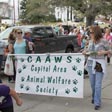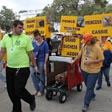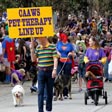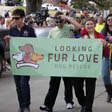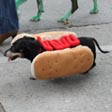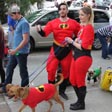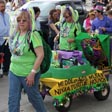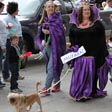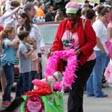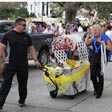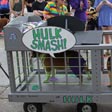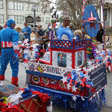In Noah's Footsteps: Traditions of Animal Rescue Groups in Baton Rouge
By Carolyn Ware

Introduction
On a Sunday afternoon in February, dozens of costumed dogs take to the streets of downtown Baton Rouge to the music of bagpipes. This is the tenth annual Mystic Krewe of Mutts walking parade, sponsored by the Capital Area Animal Welfare Society (CAAWS), an all-volunteer organization dedicated to the prevention of animal suffering in the Baton Rouge area. The krewe's royalty, King Milo and Queen Dini, are former residents of the CAAWS shelter who have been adopted into good homes. The royal court is accompanied by yet-to-be-adopted dogs wearing vests that read "Adopt Me," a reminder of the central purpose of the parade.
In accordance with the 2015 theme of "Marvelous Mutts!", many parading dogs—and some dog owners—Wonder Woman, and Mutant Ninja Turtle Hounds. Some dogs walk on leashes, and others ride in decorated, non-motorized "floats" built from children's wagons and baby buggies. Along the parade route, a number of spectators and their dogs also sport superhero suits, frilly tutus, hot dog suits (for two dachshunds), and various other costumes.
Although a relatively new tradition, the Mystic Krewe of Mutts parade has become one of the city's favorite seasonal events. The parade is only one feature of a daylong public celebration called Bark in the Park. In addition to pre-parade contests for best pet costume, best float, and best costumed group, animal welfare groups set up tables along North Boulevard at Towne Center and Galvez Plaza to offer information on their activities and raise funds through the sale of t-shirts, dog treats, and cat toys. All strive to bring attention to the many dogs, cats, and other animals who need good homes.
The popularity of the Krewe of Mutts celebration, CAAWS's largest annual fundraising event, demonstrates the region's growing concern with animal welfare. Celebrating its 35th birthday in 2015, CAAWS is Baton Rouge's oldest animal rescue organization, but at least a dozen other groups—many created in the past decade—are now active in trying to improve the lives of homeless animals. The problem is a substantial one: according to the Spay Baton Rouge organization, more than 130,000 unwanted animals enter Louisiana shelters each year, and 92,000 are euthanized there. In addition, thousands of stray and feral cats suffer outdoors (Spay Baton Rouge 2015). Until recently, there has been little political support for animal welfare and rescue initiatives, and these organizations still remain low on the funding ladder. In this context, the "dogged determination" (as a journalist/animal activist punned) of animal rescuers is particularly impressive (Hirsch 2011).
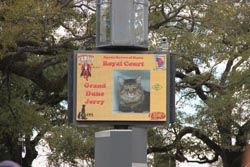
Local groups dedicated to animal welfare have a range of missions, which may include fostering and finding permanent homes for pets such as dogs, cats, rabbits, or rats; caring for feral cat colonies and limiting their size through trap, neuter, and release (TNR) programs; distributing pet food and other supplies through animal "rescue banks"; rehabilitating and releasing injured or sick wildlife (for which a special license is required); helping to draft and lobby for animal welfare-related city ordinances and state laws; offering pet owners affordable access to, and information about, spaying and neutering services; and training for animal rescue and sheltering in the event of hurricanes and other disasters. New groups often begin with one committed individual, or a handful of like-minded people who share a deep commitment to the welfare of a particular species or breed, recognize a gap in services, and decide to fill that need.
Despite differences in size, structure, and mission, there are more similarities among animal rescue groups than differences.1 Most are non-profit or private organizations, funded largely by donations and adoption fees, and all rely heavily on volunteers. All charge modest adoption fees, which can range from $25 for a pair of rats to $200 for a purebred dog; the average adoption fee is about $100. These fees cover only a small part of the cost of taking in and caring for animals, including veterinary care. (Yelp!BR, for instance, estimates that it spends an average of $500 on each healthy dog it takes in, and considerably more for those with heartworm disease and other health problems.) It is standard for dogs and cats to be spayed or neutered, vaccinated, and often microchipped before they go to adoptive homes so that they do not add to the region's large population of stray or unwanted animals.
Virtually all rescue groups depend on private foster homes to care for and socialize animals while they await adoption. Whatever their rescue niche, animal workers view educating the general public as part of their mission, advocating responsible pet ownership and the benefits of "fixing" (spaying and neutering) animals. Even the smallest groups recognize that marketing skills are crucial in finding good homes for homeless animals, and they increasingly use Facebook pages, organization websites, PetFinder, Twitter accounts, and other 21st-century means to reach out to potential adopters, donors, and volunteers.
This article first offers an overview of animal rescue groups in the greater Baton Rouge area. It provides a brief account of some of the social changes that have sparked new animal welfare initiatives, and introduces a number of the currently active groups, though it is not a comprehensive list.
Focusing primarily on animal rescue groups that seek to find good "forever" homes for dogs, cats, and other pets, the essay describes the work of contemporary animal rescue, the various roles available to volunteers, and the growing importance of social media. The final section examines a variety of rescue-related traditions. Among these are work-related vocabulary and sayings, animal naming practices, the "life stories" or biographies of individual animals, rescuers' personal experience narratives about their work and its significance to them, and customary gatherings such as adoption events and public fundraisers.



